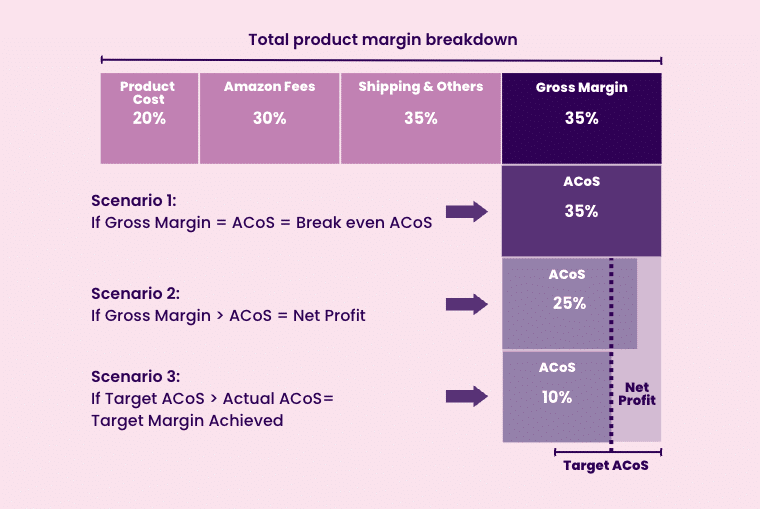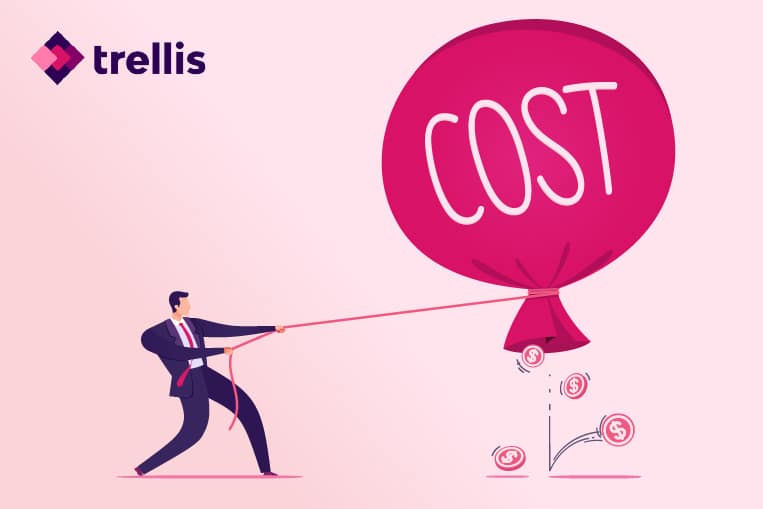Amazon ACoS (or Advertising Cost of Sale) is pivotal to helping Amazon sellers determine the cost of advertising and the profitability of a campaign.
In a competitive eCommerce landscape, one of the fastest ways to grow your sales is through advertising. But to make a profit from an Amazon PPC campaign, you have to know the actual cost of advertising.
You also need to evaluate early on whether a campaign is making a profit or not. This is where understanding and keeping track of ACoS on Amazon comes in.
Today’s quick guide helps you understand the importance of ACoS on Amazon, how to calculate it, and a few optimization tips to improve ACoS.
Let’s dive in.
What is Amazon ACoS?
ACoS is an Amazon-specific metric that measures how much you spend for every dollar of revenue you make. Amazon ACoS is expressed as a percentage, and it’s essential in helping you understand if your campaigns are profitable or not.
How to Calculate ACoS for Amazon PPC
Calculating ACoS on Amazon is pretty straightforward. Here’s a formula showing you how to do it:
ACoS = Ad Spend / Ad Revenue X 100
For instance, if you spent $60 on an Amazon PPC campaign, and gained a total sales revenue of $200, here’s how you would calculate ACoS.
$60 / $200 X 100= 30%
This result means that you spent 30 cents ($0.3) for every dollar earned from the ad.
It’s good to note that ACoS does not include other expenses such as ad production and Amazon fees. It solely measures your ad spend (the campaign budget you listed when setting up your ad on Amazon).
What is the Importance of ACoS?
We’ve touched on it already, but ACoS metric on Amazon is essential in determining your campaign’s profitability, or lack thereof. The results you get from evaluating ACoS will come in handy when iterating your ad strategy to ensure you remain profitable.
What is the Difference Between Amazon ROAS and ACoS?
Return on ad spend (ROAS) is the inverse of ACoS. ROAS is also more common in pay-per-click advertising (PPC).
ROAS shows how much revenue you get for every dollar you spend on advertising. On the other hand, ACoS on Amazon shows how much you spend for every dollar you make.
Both metrics are essential in helping you determine an Amazon PPC campaign’s effectiveness. ROAS is more concerned with the effectiveness of your ad spend, while ACoS focuses on measuring profitability.
That said, to get the complete picture of your entire Amazon campaign strategy, track both metrics.
Read more: What is a Good Amazon RoAS?
What is a Good ACoS?
There is no universal average that indicates a good or bad ACoS. A good Amazon ACoS will vary by product, industry, ad type, and campaign. Hence, an ACoS which is good for one business could be high for another. To get the whole picture of your Amazon ACoS, you’ll need to compare it within the proper context.
For example, you should compare your ACoS to other sellers in the same country, industry, and sub-category. These sellers should also run ads in the same format as yours.
In addition, a good Amazon ACoS will largely depend on your Amazon PPC campaign goals.
While you want to keep your ACoS on Amazon lower, you may sometimes target a higher ACoS. This strategy works for scenarios such as:
- Introducing a new product to market
- Getting rid of a low-selling product
- When the goal is brand awareness and visibility
- Wanting to dominate a niche
- Selling in a fiercely competitive market
However, if you want to make a profit, focus on maintaining a lower ACoS. The target ACoS in this case needs to be smaller than the profit margin, so you can still realize a profit after spending on ads.
You should utilize this strategy when the goal is to make as much profit as possible. This strategy is also solid if a product doesn’t need much visibility to sell.
That said, you’ll find that most Amazon sellers have a target advertising cost of between 30-35%.
An average of 10-20% is considered a low ACOS in most industries, while anything beyond 35% is considered high.
How to Find Your Target ACoS?
Getting the most of an Amazon ad campaign starts with finding the target ACoS. This target will depend on how much you can afford and the amount you’re willing to invest in advertising.
Here are three vital steps to determine your target Amazon ACoS.
- Know your profit margin
- Calculate the break-even point of your ACoS
- Find your target ACoS
Know your profit margin
To find your profit margin, you need to factor in production costs, Amazon fees, and shipment fees (both from the manufacturer and to customers)
Hence, the profit margin formula will be as follows if you sell without relying on ads:
Profit margin= (product price – production costs – Amazon fees – shipment fees) / product price X 100
For instance, if a product sells at $100, costs $30 to produce, $20 to ship, and $20 for the Amazon fees, your profit would be:
$100— ($30+$15+$25)= $30
To get the profit margin, divide the profit by the product price X 100
$30/$100 X 100= 30%
Your profit margin before advertising costs would be 30%.
Next, you need to determine the break-even point to help you find the target ACoS.
Calculate break-even ACoS
Making this calculation is pretty easy. The break-even point is where the cost of advertising is equal to the revenue generated through ads. In other words, the ACoS break-even point will be equal to the product’s profit margin.
When ACoS is at a break-even point, you’re neither making profits nor losses. That’s because you are using the ‘to-be profits’, (30%) in our case, to finance the ad bringing in the revenue.
The break-even is more of a tipping point that shows whether a campaign makes a profit or loss. Going back to our example, if the ACoS is more than 30%, the campaign is making a loss. If it’s less than 30%, the campaign is profitable.
So, to remain profitable, your ads should not go north of 30%. You should always try to keep them at 30%, or even better, lower.
Also, note that this ACoS break-even is based on a single product. If you want to know whether all your Amazon PPC campaigns are making or losing money, you need to group products with the same profit margin into the same campaigns. You can also decide to monitor the ACoS per product.
Calculate target ACoS
The target ACoS is the percentage where you hit your target profit margin. In other words, the target ACoS ensures that what you spend on ads brings revenue and makes a profit.
The target ACoS tells you whether your campaigns are turning a profit.
To calculate the target ACoS, first determine your profit margin after advertising. The margin you set is at your discretion and will be lower than the profit margin before advertising.
Let’s use a 10% profit margin for this example since it’s considered average in most industries. Then, we need to subtract this 10% from the profit margin before advertising.
30% – 10% = 20% (Target ACoS)
So, to consistently hit your stipulated profit margin, your ACoS on Amazon should not go beyond 20%.
While it’s easy to manually calculate the target ACoS, doing so for multiple campaigns spanning a dozen products is sure to make your head spin. Luckily you can automate the target Amazon ACoS calculation through our free ACoS calculator.
How to Use the Trellis ACoS Calculator
The Amazon ACoS calculator by Trellis is pretty easy to use. You simply need to know your production costs, the targeted profit margin, and other costs like shipments and overheads. Next, plug these costs into the calculator.
The calculator will automatically calculate and display the target ACoS for you. In just a few minutes, you can determine the target ACoS for all your campaigns without the hassle of manual calculations.

How to Reduce ACoS?
If you have a high ACoS, keep this in mind – reducing ACoS on Amazon is a case of balancing your profit margin, ad spend, and bidding strategy. If you’re to reduce your ACoS, you need to target the right keywords. The most important thing here is to work with the latest data when harvesting keywords.
You also need to make regular tweaks to your campaigns to catch an inflated ACoS early on and make the necessary changes.
In addition, focus on fewer campaigns, so you don’t spread yourself too thin. It will be harder to monitor and optimize your Amazon ACoS if you have more campaigns than you can handle running at a time.
Amazon ACoS Optimization Tips
To optimize your Amazon PPC campaign’s ACoS, you’ll need first to optimize a few other factors that drive the metric. These factors are the click-thru rate (CTR), conversion rate, and cost-per-click(CPC).
Let’s expound on each.
CTR
This metric measures the number of people who saw your ads on the Amazon platform and clicked on them. CTR is calculated by total impressions over the number of clicks. Like ACoS, CTR will vary by product, sector, and ad format.
To optimize ACoS on Amazon to a profitable level, you’ll need to improve your CTR.
Here are a few ways to do that:
- Focus on the right keywords
- Create relevant and appealing ad copy written in the customer’s language
- Improve your star rating by providing quality products and top-notch customer service
- Use high-quality visuals that depict the product properly
CPC
The cost per click metric shows what you pay every time someone clicks on your ad.
The CPC depends on your bidding strategy, ad quality score, and level of competition. Below are three tips for optimizing your CPC.
- Determine a campaign goal and target ACoS for each Amazon PPC campaign. Doing so ensures you bid for just the right amount to achieve the profit margin.
- Adjust your campaign bids regularly to reflect the market changes.
- If your ACoS on Amazon is lower than the target ACoS, increase your CPC. If ACoS is more than the target, lower the CPC.
Conversion Rate
The conversion rate shows the number of people who bought a product from your store after clicking on an Amazon ad. A higher conversion rate is often accompanied by a lower ACoS.
Conversion rate is usually influenced by the type of ad, visuals, and ad copy. So, to optimize the conversion rate, you’ll need to constantly test the ad copy, visuals, and value proposition of your products to see which works for Amazon customers.
When all three elements are optimized, you’ll find it easy to achieve your target ACoS and turn a profit by selling on Amazon. That said, as we’ve already established, calculating ACoS on Amazon for multiple campaigns and products can get messy. However, with the help of an automated calculator, you can determine the ACoS of multiple products and campaigns. This way, you’re able to run profitable Amazon PPC campaigns within your target ACoS.
Check out our free ACoS calculator, and you can tick off one more tedious task from your advertising checklist.



